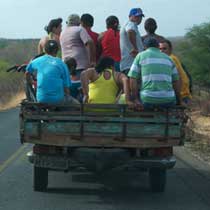Using Safety Equipment
While much of the safety equipment comes with the vehicle, some devices are not effective unless we actually use them. The most obvious are automobile seat belts and helmets for motorcyclists.
 |
Photo courtesy of Kermitz Fraga These people provide a good example of what not to do in a vehicle. Although it is often convenient to crowd everyone into the open back of a truck, this is a very dangerous way for people to travel, even for short distances. There is no protection if there is a collision. |
 |
Photo courtesy of Kermitz Fraga Cargo should be secured in trucks, because uneven roads can cause items to shake loose. It is particularly dangerous for a person to travel with the cargo in the way seen above. |
Governments have struggled with the issue of whether or not they should require a behavior—the use of seat belts and helmets—through laws. Many societies do not want to regulate personal behavior unless there are issues of public safety or other public concerns at stake. Public safety is clearly the rationale behind regulations concerning how fast we drive (speed limits) and other rules of the road.
The same is true of the requirement for driver’s licenses, usually obtainable only after passing a test. In fact, like speed limits, driver’s licenses and tests are almost as old as motor vehicles. Germany introduced them together in 1910. The state of New York began to require licenses for chauffeurs that same year, and New Jersey passed legislation that made licenses conditional on testing in 1913. Laws about driving while impaired by alcohol or other substances have also come from public-safety concerns.
Seat belts are different. A driver who does not wear one increases the likelihood of injury in a collision, as well as increasing the possibility of losing control of the automobile as he or she bounces around inside the car during the event. Not wearing a seat belt presents a big risk. That is why seat belts were one of the earliest safety devices placed in cars. Nevertheless, although governments can tell carmakers to put seat belts in their vehicles, making seat-belt use—a behavior—mandatory takes regulation into another realm. Governments in many places hesitated before taking this step.
|
This illustration from England reminds bus passengers to use their seat belts. |
Whether traveling in the city or in the mountains, motorcyclists need to wear helmets, visors, sturdy jackets, and boots, to get as much protection as possible from the road. |
|
|
A bicyclist should always wear a helmet, even for a short trip. The helmet provides the only protection for rider’s head if there is a collision. |
Adequate protective gear makes traveling by motorcycle as safe possible on an open vehicle. |
While governments wrestled with this issue, auto manufacturers put warning lights on the dashboard to remind the driver and passengers to fasten their seat belts. For a few years, buzzers sounded until the driver, and sometimes the front-seat passenger, buckled up. Even more annoying, and soon abandoned, was a design that prevented the car from starting if seat belts were not fastened. Another short-lived feature had the shoulder harness of the seat belt attached to the door; it would automatically engage when the door closed.
The Australian state governments were the first to mandate the use of seat belts. The state of Victoria took the plunge in 1970, followed gradually by the other states. Most European countries adopted such laws during the 1970s. Britain, however, did not do so until 1983. Car-safety experts in the United States calculated that the use of seat belts could save as many as 10,000 lives a year. Yet by 1981, 15 years after the U.S. government had mandated their installation, only 11% of Americans were using them. Finally, in 1984, New York State led the way in requiring the use of seat belts, and eventually every state except New Hampshire passed such laws. These laws are now quite rigorously enforced. Around the world, Japan added seat-belt laws in 1985, Argentina in 1992, Brazil in 1995, Egypt in 2000, and Nigeria in 2003. Most countries also mandate specially sized seats and restraints for infants and young children.
Research indicates that lap/shoulder seat belts, when used, reduce the risk of fatal injury to front-seat occupants by 45% and the risk of moderate-to-critical injuries by 50%. Seat belts are equally important for rear-seat passengers, who can injure themselves and people in the front seats in an accident if they are unrestrained. In most countries, increased seat-belt use has reduced the number of injuries from collisions.
One important thing to remember is that air bags, which deploy automatically in a crash, do not work properly if the driver and front-seat passenger are not wearing seat belts. Air bags open with explosive force and are designed to protect restrained drivers and passengers. Anyone not wearing a seat belt can be seriously injured by the opening of an air bag, because their body is not in the position the air bag is designed to protect.
Another piece of safety equipment that works only if we put it on is the helmet, for motorcycle riders (and bicyclists). The helmet protects the rider’s head if it hits the ground during a collision, thus helping to prevent head injuries. The history of helmet use parallels the development of the motorcycle.
The first motorcycles with internal combustion engines developed at the end of the 19th century. The Americans William Harley (1880-1943) and Arthur Davidson (1881-1950) joined forces to create their first successful motorbike in 1903. The early motorcycles didn’t go very fast, but, as with cars, the designers quickly went to work to increase their power and speed. But as power and speed increased, accidents began to occur with great frequency. And often these accidents were fatal. One famous victim was T. E. Lawrence (1888-1935), the Englishman known as Lawrence of Arabia. While riding his motorcycle on a country road, he swerved to avoid two bicyclists whom he had failed to see because of a dip in the road. He lost control and was thrown over the handlebars. He died six days later from head injuries.
One of the doctors who attended Lawrence began to campaign for the adoption of crash helmets for motorcyclists. However, it was not until the early 1950s that a helmet designed to absorb the shock of impact was patented, in the United States.
Helmets clearly reduce injuries and fatalities in motorcycle accidents. Most countries, therefore, now mandate their use. However, as with seat belts, there has been some resistance to telling people what to do in this regard. This is particularly true in the United States, where even today there are states that do not require the wearing of a helmet.
Bicycle helmet laws are the next road-safety frontier. Some countries have instituted mandatory helmet laws for all cyclists. Some countries or communities within countries have helmet laws for children only, while others have no helmet laws. The World Health Organization has started an initiative to promote the wearing of bicycle helmets. All professional cyclists wear helmets designed to reduce wind resistance while protecting from head injuries.
This content has been re-published with permission from SEED. Copyright © 2025 Schlumberger Excellence in Education Development (SEED), Inc.


.gif?n=899)


